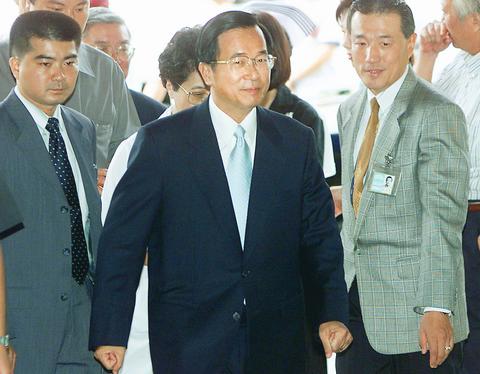DPP officials restated the party's position of sticking to the "five no's" policy, after Beijing issued a tough-worded warning following President Chen Shui-bian's (陳水扁) remarks when he referred to Taiwan and China as "separate states on either side of the Taiwan Strait."
Expressing his regret over China's denunciation, DPP Director of the Chinese Affairs Department Chen Chung-hsin (
Responding to China's accusation that the president was steering the nation toward independence, Chen Chung-hsin said, "we are not surprised by China's reaction. But we'd like to reiterate that the DPP will continue to make good on the `five no's' policy."

PHOTO: REUTERS
In his strongest comments since he took office in May 2000, the president said on Saturday that there is one country on either side of the Taiwan Strait and that Taiwan must seriously consider passing legislation to prepare for a referendum to protect the country's sovereignty.
In response, Beijing warned the president that his call for the legislation would seriously damage relations between the two sides, and "bring Taiwan into disaster."
The spokesman of China's Taiwan Affairs Office, Li Weiyi (李維一), said Chen's statements proved that his "five no's" policy was merely an expedient measure aimed at deceiving the people of Taiwan and world opinion.
When he took office, Chen vowed to cling to the "five no's policy" as long as Beijing has no intention of using military force against Taiwan.
The "five no's" policy states that Taiwan will: not declare independence; not change the name of the nation; not change the Constitution to include the so-called "state-to-state" model of cross-strait relations; not promote a referendum to change the status quo regarding the question of independence or unification and not abolish the National Reunification Council or the National Reunification Guidelines.
Regarding China's labeling of the president as a splittist who seeks to declare independence, Chen Chung-hsin said the statement shows that "China has over-interpreted the president's remarks."
He said that the president's remarks aimed to underscore Taiwan's independent status in accordance with the party's "1999 resolution regarding Taiwan's future."
Considered the party's primary guideline when dealing with cross-strait issues, the resolution declares that Taiwan is an independent sovereign state whose name is the ROC. Any changes regarding this status quo must be collectively determined by all people in Taiwan through a public referendum.
According to the DPP, Taiwan's independence is a reality, the referendum would only apply if Taiwanese wanted to decide if they want to reunite with China.
Executive Director of the DPP's Policy Research and Coordinating Committee Lin Cho-shui (
The poll indicates that 54 percent of the respondents approved of Chen's statements that Taiwan and China are two different nations, whereas 62 percent of the respondents agreed to use a referendum to decide Taiwan's future.

SHIPS, TRAINS AND AUTOMOBILES: The ministry has announced changes to varied transportation industries taking effect soon, with a number of effects for passengers Beginning next month, the post office is canceling signature upon delivery and written inquiry services for international registered small packets in accordance with the new policy of the Universal Postal Union, the Ministry of Transportation and Communications said yesterday. The new policy does not apply to packets that are to be delivered to China, the ministry said. Senders of international registered small packets would receive a NT$10 rebate on postage if the packets are sent from Jan. 1 to March 31, it added. The ministry said that three other policies are also scheduled to take effect next month. International cruise ship operators

NUMBERS IMBALANCE: More than 4 million Taiwanese have visited China this year, while only about half a million Chinese have visited here Beijing has yet to respond to Taiwan’s requests for negotiation over matters related to the recovery of cross-strait tourism, the Tourism Administration said yesterday. Taiwan’s tourism authority issued the statement after Chinese-language daily the China Times reported yesterday that the government’s policy of banning group tours to China does not stop Taiwanese from visiting the country. As of October, more than 4.2 million had traveled to China this year, exceeding last year. Beijing estimated the number of Taiwanese tourists in China could reach 4.5 million this year. By contrast, only 500,000 Chinese tourists are expected in Taiwan, the report said. The report

The Forestry and Nature Conservation Agency yesterday launched a gift box to market honey “certified by a Formosan black bear” in appreciation of a beekeeper’s amicable interaction with a honey-thieving bear. Beekeeper Chih Ming-chen (池明鎮) in January inspected his bee farm in Hualien County’s Jhuosi Township (卓溪) and found that more than 20 beehives had been destroyed and many hives were eaten, with bear droppings and paw prints near the destroyed hives, the agency said. Chih returned to the farm to move the remaining beehives away that evening when he encountered a Formosan black bear only 20m away, the agency said. The bear

Chinese embassy staffers attempted to interrupt an award ceremony of an international tea competition in France when the organizer introduced Taiwan and displayed the Republic of China flag, a Taiwanese tea farmer said in an interview published today. Hsieh Chung-lin (謝忠霖), chief executive of Juxin Tea Factory from Taichung's Lishan (梨山) area, on Dec. 2 attended the Teas of the World International Contest held at the Peruvian embassy in Paris. Hsieh was awarded a special prize for his Huagang Snow Source Tea by the nonprofit Agency for the Valorization of Agricultural Products (AVPA). During the ceremony, two Chinese embassy staffers in attendance